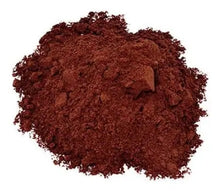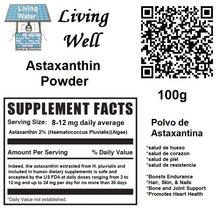Livingwell Astaxanthin Powder
A natural, red pigmented ketocarotenoid (or plant color) found in some types of microalgae and yeast. It’s mainly found in Haematococcus pluvialis, a type of algae, and Xanthophyllomyces dendrorhous, a type of yeast.
This ketocarotenoid shares some chemical similarities with carotenes, which are also plant colors, like lycopene and beta carotene. However, it is more closely related to oxygenated xanthophylls (an oxygen-rich plant color) like lutein and zeaxanthin, which are known for improving eye health.
Algae and yeast produce and accumulate astaxanthin naturally. It serves as a food source for marine species like crawfish, lobster, krill, salmon, trout, shrimp, and crab, that transfer this pigment up the food chain. Crustaceans accumulate astaxanthin in their shells and flesh, while salmon and trout build up this pigment in their flesh. Consuming seafood rich in astaxanthin can provide you with certain health benefits.
Astaxanthin is a red pigment found in marine animals and microorganisms, whereas lutein and Zeaxanthin are yellow pigments found in vegetables and fruits. These xanthophyll carotenoids can act as antioxidants by capturing free radicals and oxygen singlets
Health Benefits
As a carotenoid, astaxanthin is a fat-soluble pigment with powerful antioxidant properties that plays a role in protecting your cells from free radicals and oxidative stress. Carotenoids are known for their ability to neutralize reactive oxygen, on the inner and outer layers of cell membranes.
In addition, astaxanthin may provide health benefits such as:
Immune System Support
Astaxanthin can influence your immune system, helping to activate white blood cells (T-cells) and natural killer (NK) cells.
While T-cells attack foreign cells based on antigen markers, NK cells don't require activation and work at a faster speed to stop invasions that can weaken your health.
Try This Exercise For Your Golf Swing
Health Risks
Astaxanthin has several health benefits, but it comes with a few risks such as:
Blood Pressure Medication Interaction
Since astaxanthin may help to lower blood pressure, you should not take it if you have been prescribed blood pressure medication by your doctor.
Pregnancy and Breastfeeding
It is unknown whether astaxanthin causes side effects if you are pregnant or breastfeeding. To avoid potential risks, do not take astaxanthin supplements or high quantities of astaxanthin-rich foods while pregnant or nursing a child.
Astaxanthin is a carotenoid pigment with powerful antioxidant properties. However to summarize the health benefits are many:
It protects cells from oxidative stress and damage.
It improves the immune system function.
It promotes skin, eye, heart, and brain health.
It enhances endurance and reduces fatigue.
It reduces inflammation and pain.
It may improve male fertility.
It may help with diabetes and obesity.
¿Qué es la Astaxantina?
La Astaxantina es un carotenoide de coloración rosada que se genera naturalmente en las microalgas de agua dulce, llamadas haematococcus pluvialis.
Sirve de alimentación al zooplancton y al krill, que al mismo tiempo son la alimentación de pescados como el salmón o la trucha. También suele ser el alimento de crustáceos como el cangrejo o el de aves como el flamenco.
¿Para qué sirve la Astaxantina?
La Astaxantina, tal y como se ha constatado en diferentes estudios científicos, como en Astaxanthin: a review of its chemistry and applications, sirve como antioxidante natural, siendo un potente aliado contra los signos de la edad.
Al igual, es muy útil para prevenir ciertas enfermedades como el alzhéimer, las cataratas o el párkinson.
Astaxantina: Propiedades y Beneficios, Propiedades de la Astaxantina
La Astaxantina es una sustancia versátil con múltiples propiedades. Por ejemplo, gracias a distintos estudios como el International Journal of Molecular Medicine, se ha verificado sus propiedades anticancerígenas.
En esta misma línea, en la revista Antioxidants también se ha publicado una investigación en la que se ha demostrado que la Astaxantina es beneficiosa para luchar contra el cáncer.
Por otro lado, otra de las propiedades de la Astaxantina es que es un complemento útil a la hora de conservar la plasticidad neuronal, por lo que gracias a sus beneficios antiinflamatorios y antioxidantes esta sustancia es una aliada para prevenir enfermedades neurológicas.
Beneficios de la Astaxantina
La Astaxantina, además de las propiedades que te hemos comentado, también tiene otros beneficios muy potentes para la salud. Un ejemplo es que la Astaxantina ayuda a equilibrar el metabolismo lípido y los niveles de colesterol.
Por esta razón, tomar Astaxantina es un hábito idóneo en situaciones en las que se desea controlar la grasa o tomar un complemento específico para el hígado graso.
¿Cual es la mejor Astaxantina?
La mejor Astaxantina es aquella que es pura y que no contiene otros ingredientes añadidos que puedan ser perjudiciales para la salud.
Al igual, es recomendable elegir un producto que esté enriquecido con otras vitaminas, como la vitamina A, C o E, ya que estas ayudan a proteger a las células del daño oxidativo, potenciando así el efecto de la Astaxantina.
Sirve de alimentación al zooplancton y al krill, que al mismo tiempo son la alimentación de pescados como el salmón o la trucha. También suele ser el alimento de crustáceos como el cangrejo o el de aves como el flamenco.
¿Cuáles son los principales beneficios de la astaxantina? Además de frenar el envejecimiento y ser un buen antiinflamatorio, propiedades que ya hemos comentado anteriormente, la astaxantina también mejora la elasticidad de la piel, haciendo más fuerte la capa de colágeno de la misma






